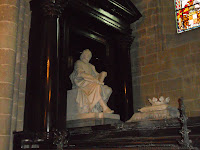Excavations carried out from the end of the 19th century, in particular by the archeologist Albert Naef (1862-1936), affirm that this site has been occupied since the Bronze Age.
 |
| Side View |
 |
| Entry Drive |
In its current state, the Castle of Chillon is the result of several centuries of constant building, adaptations, renovations and restorations.
The rocky island on which the castle is built, was both a natural protection and a strategic location to control the passage between northern and southern Europe.
The history of the castle was influenced by three major periods:
- The Savoy period (12th century to 1536)
The oldest written document mentioning the castle dates from 1150; it says that the House of Savoy already controlled the route along the shores of Lake Geneva.
- The Bernese period (1536-1798)
The Swiss, more precisely the Bernese, conquered the Pays de Vaud and occupied Chillon in 1536. The castle retained it's role as a fortress, arsenal and prison for over 260 ans.
- The Vaudois period (1798 to the present)
The Bernese left Chillon in 1798 at the time of the Vaudois Revolution. The castle became the property of the Canton of Vaud when it was founded in 1803. The restoration of the historical monument began at the end of the 19th Century and continues to this day.
 |
| Map |
 |
| Chapel |
 |
| Stained Glass Window |











